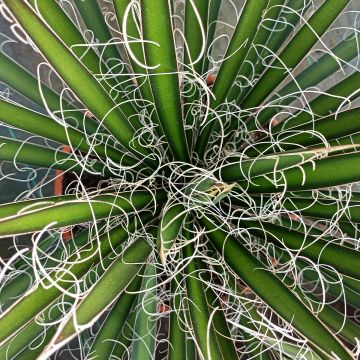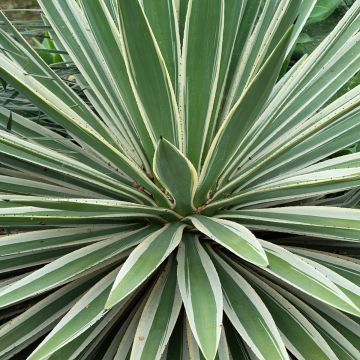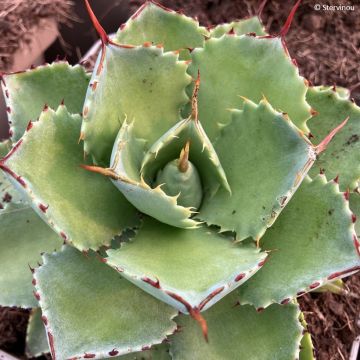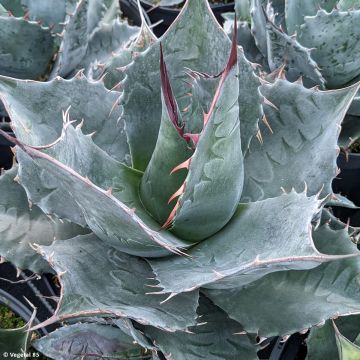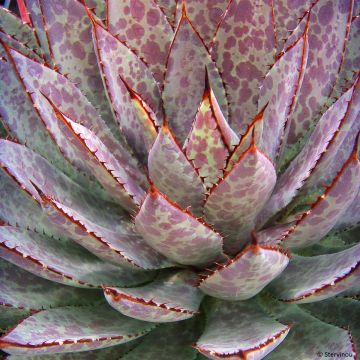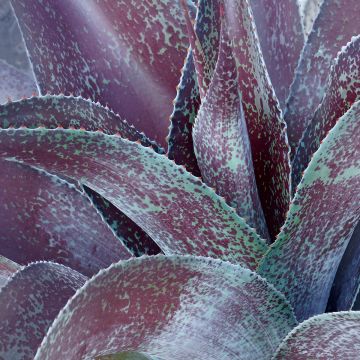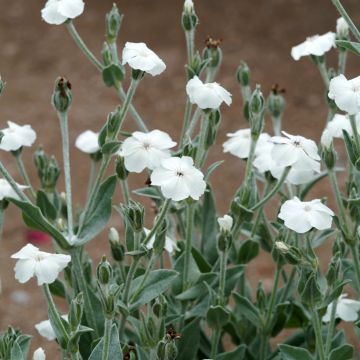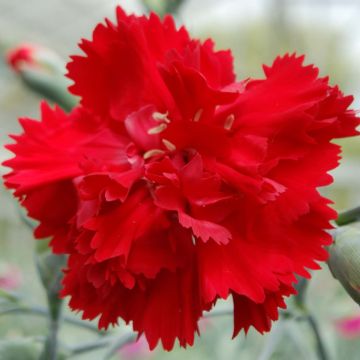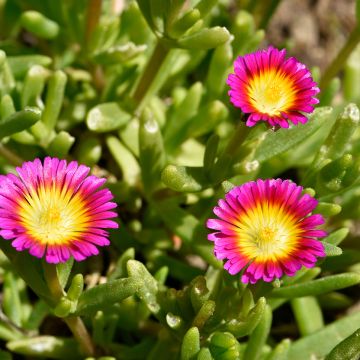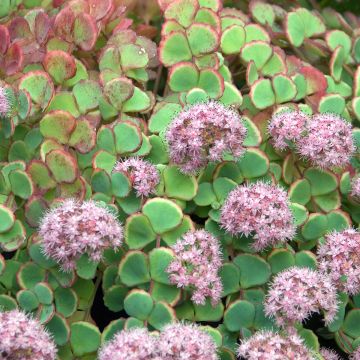

Agave Mediopicta Alba - American Agave


Agave Mediopicta Alba - American Agave
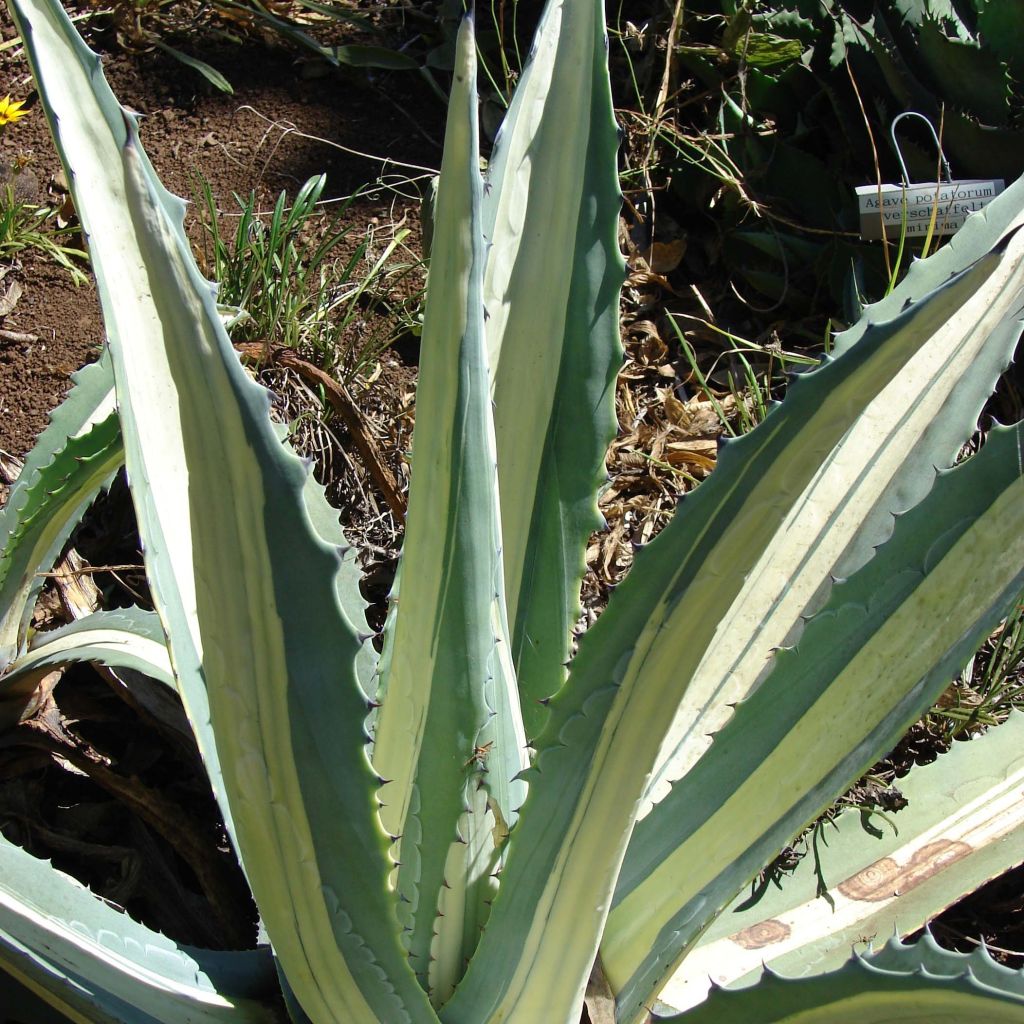

Agave Mediopicta Alba - American Agave


Agave Mediopicta Alba - American Agave
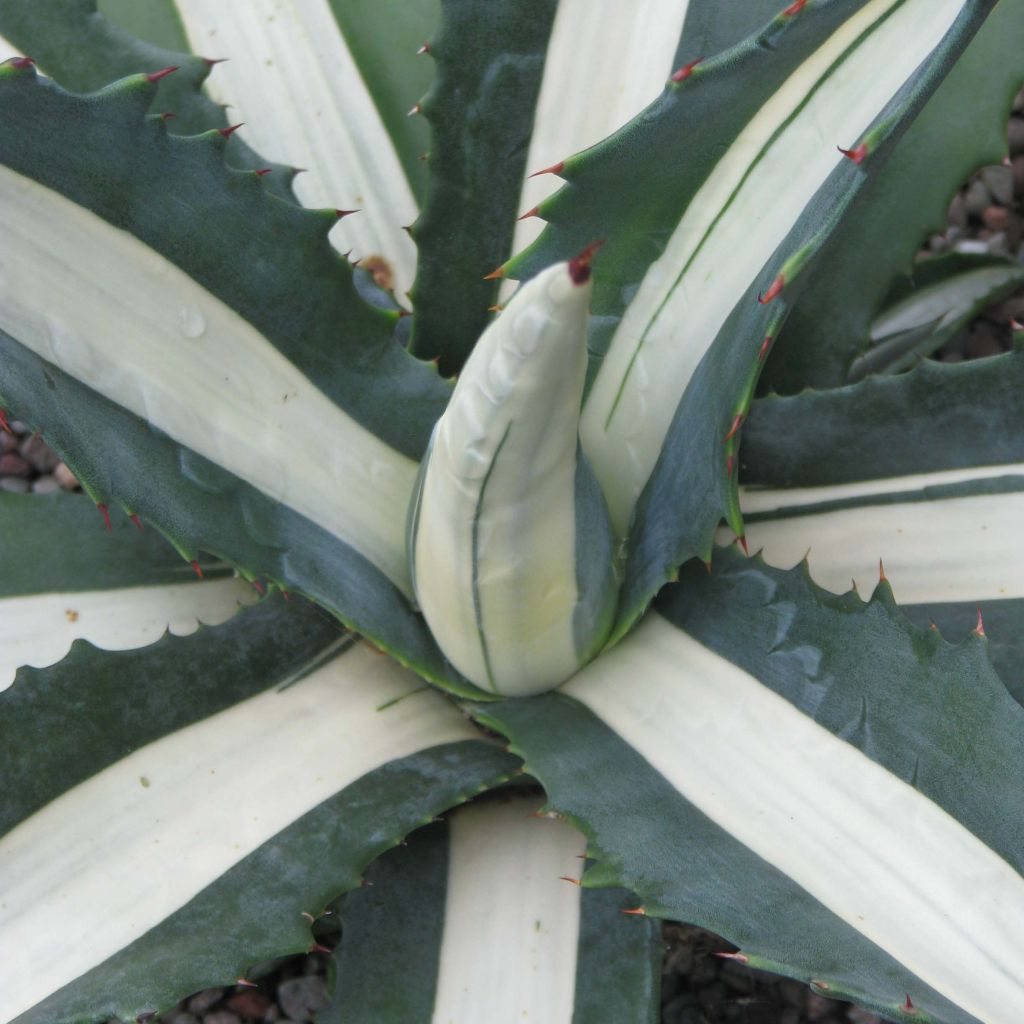

Agave Mediopicta Alba - American Agave


Agave Mediopicta Alba - American Agave
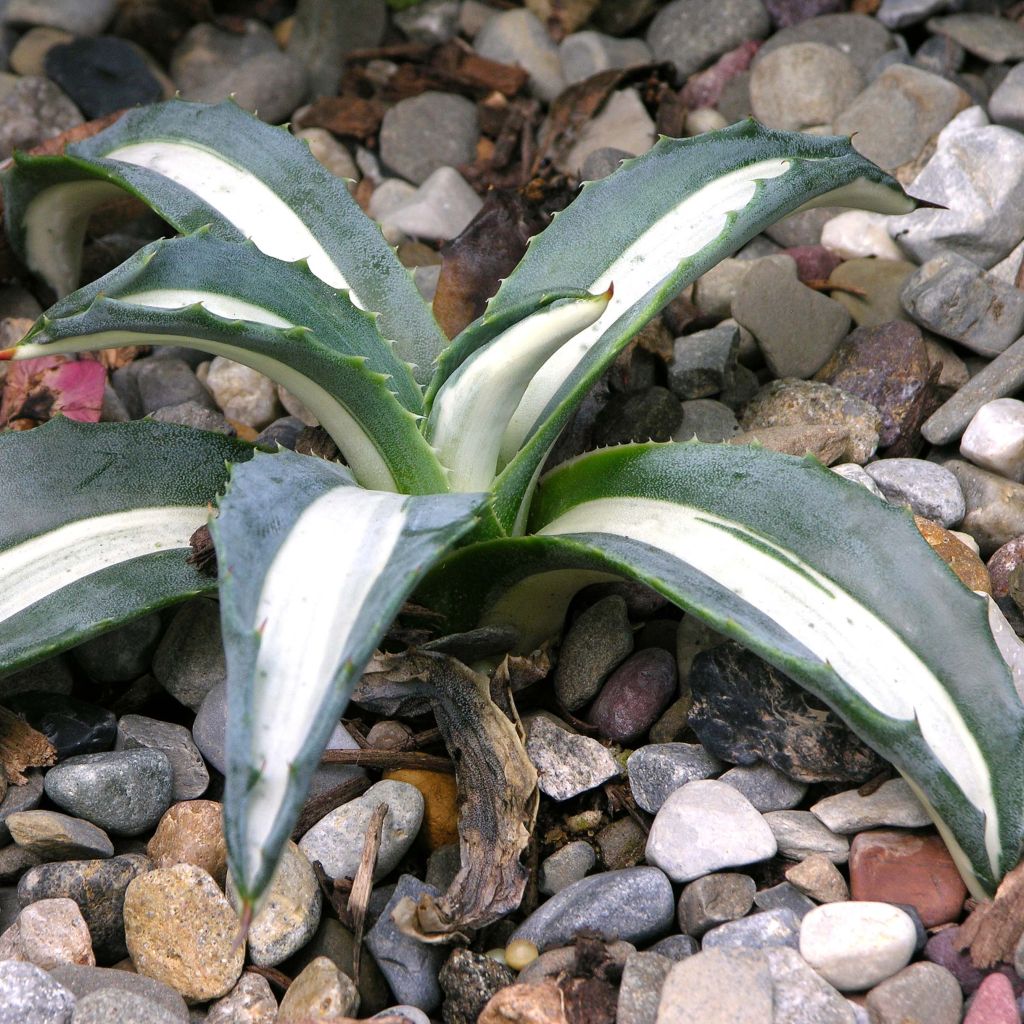

Agave Mediopicta Alba - American Agave
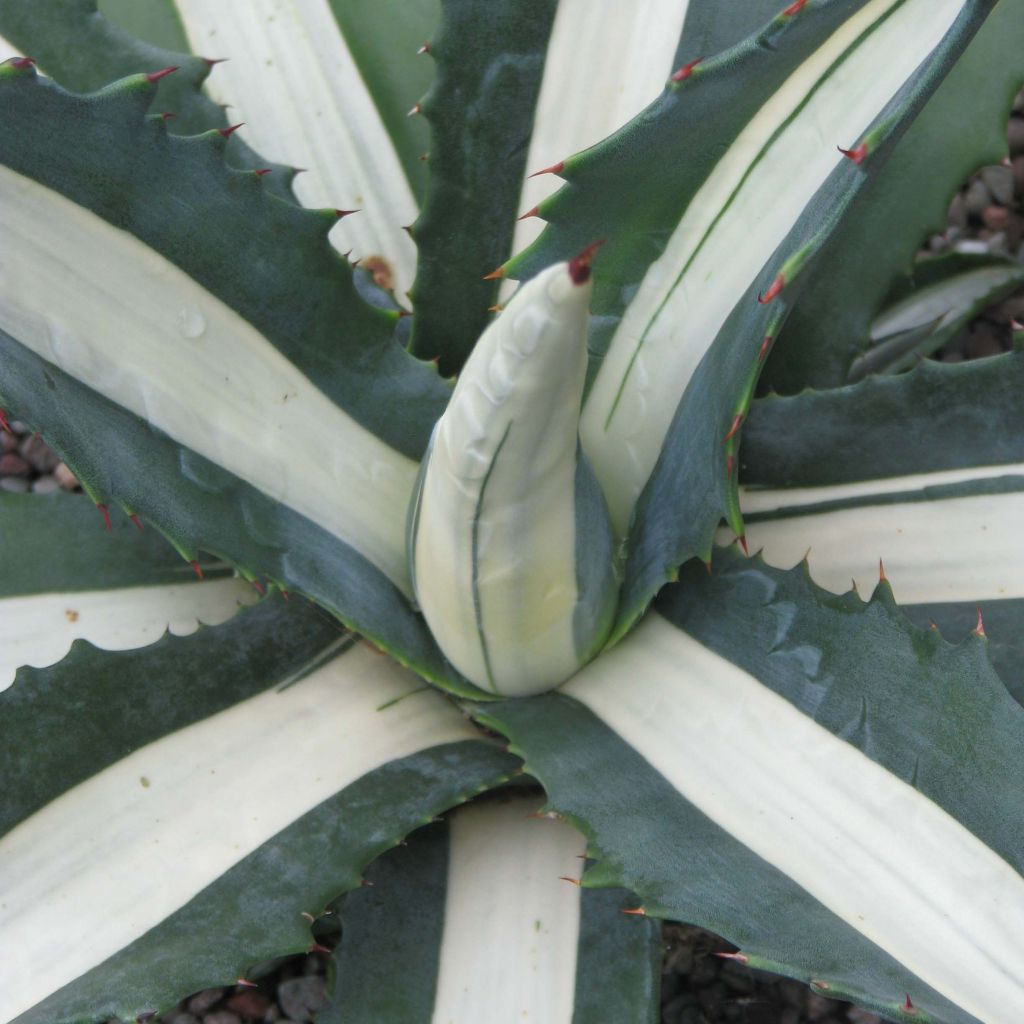

Agave Mediopicta Alba - American Agave


Agave Mediopicta Alba - American Agave
Agave Mediopicta Alba - American Agave
Agave americana mediopicta Alba
Century plant
What a disappointment when I opened the package. The vine-plant had come out of its pot with broken leaves. A embossed cardboard surround and 2 stakes were not enough. It's not ruined and I planted it, arranging it to be on its best side. I'm a little disappointed especially since the leaves of this agave have a nice trailing habit when the leaves are entire. Usually, I don't encounter any problems. During my first purchase for the same plant, I didn't have any leaf breakages. We all know that packages are mishandled. For all fragile plants with brittle leaves, maybe a better adapted protective system should be reconsidered to withstand transport conditions.
Beatrice, 29/10/2023
This item cannot be shipped to the selected country
Delivery charge from €5.90
Delivery charge from €5.90
More information
Schedule delivery date,
and select date in basket
This plant carries a 12 months recovery warranty
More information
We guarantee the quality of our plants for a full growing cycle, and will replace at our expense any plant that fails to recover under normal climatic and planting conditions.
From €5.90 for pickup delivery and €6.90 for home delivery
Express home delivery from €8.90.
From €5.90 for pickup delivery and €6.90 for home delivery
Express home delivery from €8.90.
Does this plant fit my garden?
Set up your Plantfit profile →
Description
Agave Mediopicta 'Alba' is a beautiful form of the Mexican Agave, which stands out for its reduced growth and its superbly coloured leaves, marked by a wide white central band. Perfectly adapted to dry and hot climates and poor soils, but slightly less hardy than the type, it has a strongly exotic silhouette, forming rosettes of large, stiff, succulent, and pointed leaves. It is also a well-armed plant, with sharp tips to be wary of. Flowering is rarely observed in this form. When it does flower, it emerges from the hearts of the oldest rosettes, in the form of tall, majestic flower stalks bearing panicles of yellow-green flowers. A perennial with a unique design, highly appreciated in landscape art for its unusual silhouette and absolutely stunning colour.
Native to Mexico and the southwestern United States, the extremely decorative American Agave is above all a botanical species adapted to semi-desert climates, now naturalised almost everywhere in the world, including Pakistan and China. It belongs to the Asparagaceae family, just like Yuccas or Tuberose. This perennial succulent herbaceous plant has rhizomes capable of producing suckers, but it is almost devoid of aerial stems.
Agave Mediopicta 'Alba', probably derived from the protoamericana American Agave, distinguishes itself from the type by its more modest growth and its greenish-blue leaves adorned with a wide white-cream central band. Slow-growing, this perennial is composed of about thirty leaves forming a basal rosette, 1 m (3.3 ft) tall and wide. The thick, wide, pointed leaves can reach a length of 40 cm (15.7 in) and a width of 15 cm (5.9 in). They are smooth, rigid, and sheathing at the base, bordered by grey to brown spines along their entire length. The tip of each leaf, equipped with a sharp spine, is arranged diagonally downwards and measures 2 cm to 4 cm (0.8 in to 1.6 in) in length. Occasionally, a rosette that has reached the venerable age of 15 to 20 years or even more, produces a flower stalk reaching a height of 3 m to 6 m (9.8 ft to 19.7 ft). It bears numerous horizontal branches. The branches bear flattened and spherical panicles, 7 cm to 10 cm (2.8 in to 3.9 in) wide, composed of a myriad of small yellow-green flowers. The rosette, classified as semelparous, dies after flowering, which lasts several months, having taken care to produce a few small peripheral rosettes to ensure its perpetuation. Note that this variety does not produce many offsets and is therefore not invasive.
In a mild climate, this agave will suit a large rockery or at the edges of a dry garden, where its strange yet proud silhouette will stand out against a blue sky. It can be associated with the prickly pear, Yucca rigida, Nolina siberica, giant fennel, fairly hardy candle cacti (Cleistocactus strausii, Cylindropuntia imbricata), and equally robust echium from the Canary Islands. Gardeners in colder regions can plant it in a very large pot on a terrace, carefully choosing the most sheltered and sunny spot to recreate a setting inspired by gardens and patios that flourish in more exotic climes. Cultivated in this way, it will show slightly less growth. This plant is hardy down to about -10° C (14° F) in perfectly drained soil, even dry in winter.
The Agave is also an edible plant, used in Mexico to make mescal, an alcoholic beverage obtained by fermenting its juice, which is rich in sugars. It is also used in traditional medicine in Mexico, Brazil, and India, and has proven antifungal properties. Very attractive to bees and nectar-feeding insects, the inflorescences attract many pollinators.
Report an error about the product description
Agave Mediopicta Alba - American Agave in pictures






Flowering
Foliage
Plant habit
Botanical data
Agave
americana
mediopicta Alba
Agavaceae
Century plant
North America
Other Agave
Planting and care
Outside the area of the Orangery, this agave should be cultivated in pots for winter storage. Plant Agave Mediopicta 'Alba' in full sun, in a preferably poor but well-drained soil. It can also tolerate rocky, sandy and limestone soil as long as it is well-draining. It cannot endure winter humidity combined with cold, but perfectly tolerates arid situations and dry soils in summer. In dry soil and with winter protection, it will withstand frost to approximately -10° C (14° F).
It can be grown in a large, wide pot, preferably terracotta or wooden. Overwinter it indoors or in a cold greenhouse, protected from frost. Reduce watering over winter.
Planting period
Intended location
Care
-
, onOrder confirmed
Reply from on Promesse de fleurs
Mediterranean perennials
Haven't found what you were looking for?
Hardiness is the lowest winter temperature a plant can endure without suffering serious damage or even dying. However, hardiness is affected by location (a sheltered area, such as a patio), protection (winter cover) and soil type (hardiness is improved by well-drained soil).

Photo Sharing Terms & Conditions
In order to encourage gardeners to interact and share their experiences, Promesse de fleurs offers various media enabling content to be uploaded onto its Site - in particular via the ‘Photo sharing’ module.
The User agrees to refrain from:
- Posting any content that is illegal, prejudicial, insulting, racist, inciteful to hatred, revisionist, contrary to public decency, that infringes on privacy or on the privacy rights of third parties, in particular the publicity rights of persons and goods, intellectual property rights, or the right to privacy.
- Submitting content on behalf of a third party;
- Impersonate the identity of a third party and/or publish any personal information about a third party;
In general, the User undertakes to refrain from any unethical behaviour.
All Content (in particular text, comments, files, images, photos, videos, creative works, etc.), which may be subject to property or intellectual property rights, image or other private rights, shall remain the property of the User, subject to the limited rights granted by the terms of the licence granted by Promesse de fleurs as stated below. Users are at liberty to publish or not to publish such Content on the Site, notably via the ‘Photo Sharing’ facility, and accept that this Content shall be made public and freely accessible, notably on the Internet.
Users further acknowledge, undertake to have ,and guarantee that they hold all necessary rights and permissions to publish such material on the Site, in particular with regard to the legislation in force pertaining to any privacy, property, intellectual property, image, or contractual rights, or rights of any other nature. By publishing such Content on the Site, Users acknowledge accepting full liability as publishers of the Content within the meaning of the law, and grant Promesse de fleurs, free of charge, an inclusive, worldwide licence for the said Content for the entire duration of its publication, including all reproduction, representation, up/downloading, displaying, performing, transmission, and storage rights.
Users also grant permission for their name to be linked to the Content and accept that this link may not always be made available.
By engaging in posting material, Users consent to their Content becoming automatically accessible on the Internet, in particular on other sites and/or blogs and/or web pages of the Promesse de fleurs site, including in particular social pages and the Promesse de fleurs catalogue.
Users may secure the removal of entrusted content free of charge by issuing a simple request via our contact form.
The flowering period indicated on our website applies to countries and regions located in USDA zone 8 (France, the United Kingdom, Ireland, the Netherlands, etc.)
It will vary according to where you live:
- In zones 9 to 10 (Italy, Spain, Greece, etc.), flowering will occur about 2 to 4 weeks earlier.
- In zones 6 to 7 (Germany, Poland, Slovenia, and lower mountainous regions), flowering will be delayed by 2 to 3 weeks.
- In zone 5 (Central Europe, Scandinavia), blooming will be delayed by 3 to 5 weeks.
In temperate climates, pruning of spring-flowering shrubs (forsythia, spireas, etc.) should be done just after flowering.
Pruning of summer-flowering shrubs (Indian Lilac, Perovskia, etc.) can be done in winter or spring.
In cold regions as well as with frost-sensitive plants, avoid pruning too early when severe frosts may still occur.
The planting period indicated on our website applies to countries and regions located in USDA zone 8 (France, United Kingdom, Ireland, Netherlands).
It will vary according to where you live:
- In Mediterranean zones (Marseille, Madrid, Milan, etc.), autumn and winter are the best planting periods.
- In continental zones (Strasbourg, Munich, Vienna, etc.), delay planting by 2 to 3 weeks in spring and bring it forward by 2 to 4 weeks in autumn.
- In mountainous regions (the Alps, Pyrenees, Carpathians, etc.), it is best to plant in late spring (May-June) or late summer (August-September).
The harvesting period indicated on our website applies to countries and regions in USDA zone 8 (France, England, Ireland, the Netherlands).
In colder areas (Scandinavia, Poland, Austria...) fruit and vegetable harvests are likely to be delayed by 3-4 weeks.
In warmer areas (Italy, Spain, Greece, etc.), harvesting will probably take place earlier, depending on weather conditions.
The sowing periods indicated on our website apply to countries and regions within USDA Zone 8 (France, UK, Ireland, Netherlands).
In colder areas (Scandinavia, Poland, Austria...), delay any outdoor sowing by 3-4 weeks, or sow under glass.
In warmer climes (Italy, Spain, Greece, etc.), bring outdoor sowing forward by a few weeks.

































